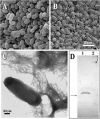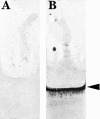Analyses of the red-dry-rough phenotype of an Escherichia coli O157:H7 strain and its role in biofilm formation and resistance to antibacterial agents
- PMID: 16597958
- PMCID: PMC1449024
- DOI: 10.1128/AEM.72.4.2564-2572.2006
Analyses of the red-dry-rough phenotype of an Escherichia coli O157:H7 strain and its role in biofilm formation and resistance to antibacterial agents
Abstract
In a previous study, we identified Congo red-binding and -nonbinding phase variants of Escherichia coli serotype O157:H7 strain ATCC 43895. The Congo red-binding variant, strain 43895OR, produced a dry, aggregative colony that was similar to the red, dry, and rough (rdar) phenotype characteristic of certain strains of Salmonella. In contrast, variant 43895OW produced a smooth and white colony morphology. In this study, we show that, similar to rdar strains of Salmonella enterica serovar Typhimurium, strain 43895OR forms large aggregates in broth cultures, firm pellicles at the air-medium interface on glass, and dense biofilms on glass and polystyrene. However, unlike S. enterica serovar Typhimurium, strain 43895OR does not stain positive for cellulose production. When strain 43895OR was fixed on agar, scanning electron microscopy showed cells expressing extracellular matrix (ECM) containing curli fibers. Strain 43895OW was devoid of any ECM or curli fibers on agar but showed expression of curli fibers during attachment to glass. Strain 43895OR produced >4-fold-larger amounts of biofilm than strain 43895OW on polystyrene, glass, stainless steel, and Teflon; formation was >3-fold higher in rich medium than in nutrient-limited medium. Biofilm-associated cells of both strains showed statistically greater resistance (P < 0.05) to hydrogen peroxide and quaternary ammonium sanitizer than their respective planktonic cells. This study shows that the rdar phenotype of E. coli O157:H7 strain 43895OR is important in multicellular growth, biofilm formation, and resistance to sanitizers. However, the lack of cellulose production by strain 43895OR indicates important differences in the ECM composition compared to that of Salmonella.
Figures






References
-
- Austin, J. W., G. Sanders, W. W. Kay, and S. K. Collinson. 1998. Thin aggregative fimbriae enhance Salmonella enteritidis biofilm formation. FEMS Microbiol. Lett. 162:295-301. - PubMed
-
- Ben Nasr, A., A. Olsén, U. Sjöbring, W. Müller-Esterl, and L. Björck. 1996. Assembly of human contact phase proteins and release of bradykinin at the surface of curli-expressing Escherichia coli. Mol. Microbiol. 20:927-935. - PubMed
-
- Carpentier, B., and O. Cerf. 1993. Biofilms and their consequences, with particular reference to hygiene in the food industry. J. Appl. Bacteriol. 75:499-511. - PubMed
MeSH terms
Substances
LinkOut - more resources
Full Text Sources
Medical
Molecular Biology Databases

